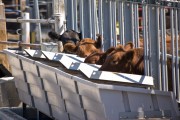MU Researchers Help Identify Cows That Gain More While Eating Less
Mizzou scientist leads the effort to help farmers decrease feed costs
September 30th, 2009

Cows eat at a special bunk, or trough, that records how much they eat and how long they stand at the bunk. MU Research Monty Kerley says that if farmers can selectively breed cattle, they could cut their feed costs by as much as 40 percent.
COLUMBIA, Mo. – With more than 2 million cows on 68,000 farms, Missouri is the third-largest beef producer in the nation. Due to rising feed prices, farmers are struggling to provide feed for the cows that contribute more than $1 billion to Missouri’s economy. University of Missouri researcher Monty Kerley, professor of animal nutrition in the College of Agriculture, Food and Natural Resources, is studying how cows might be able to gain more weight while consuming less, potentially saving farmers up to 40 percent of feed costs.
Two years ago, MU researchers started studying which biological processes could make cows feed-efficient. They examined the basic compound that cells use for energy, commonly known as ATP, using previous research that demonstrated how DNA influences weight gain in cows. Some animals can synthesize ATP faster than others, helping them to use energy more efficiently and, thus, gain more weight with less food. Kerley hopes that farmers will use this research to breed more feed-efficient cattle.
“We would love to go to the rancher and say, ‘you can reduce your feed cost 40 percent with the same weight gain,’” Kerley said.
Kerley and his team are using a feed and weighing system that records individual intake and body weight of cattle daily. This research is being done at the Beef Research and Teaching Farm facility in MU’s South Farm Agricultural Experiment Station. Whenever an animal steps to the bunk, or a trough, a computer notes the cows’ arrival and departure times and how much they eat. When they drink, they stand on scales that keep track of their weights. If a beef producer just selected the top one-third of their most efficient cows, forage intake would be reduced by 20 percent, Kerley said.
Kerley said that when feed intake is reduced, methane emissions and manure production also decrease.
“If ‘cap and trade’ regulations, in some form, become part of America, it is likely that cattle producers will have to defend themselves against claims of methane emission by ruminants,” Kerley said. “If a farmer can demonstrate reduced carbon production, then he or she might be able to ‘sell’ production credits on an exchange. That could provide the farmer with an additional income stream.”
Beef producers are using this research to make genetic selections in their beef herds. Missouri was one of the first states to have a private bull testing facility that tests for efficiency. The Division of Animal Sciences also has a research emphasis to study genetic control of feed efficiency and methods to predict animal efficiency.
Kerley’s research has been published in a variety of scientific journals.

